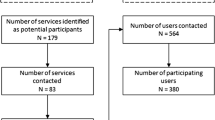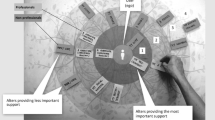Abstract
This study analyzed the relationship between social network dynamics and initial help-seeking behaviors. The primary social network was reconstructed for the period beginning with initial observation of unusual behavior and ending with first psychiatric hospitalization. The social network's influence was analyzed based on the concept of social network cohesion, considering both structure and content of social ties. The results demonstrate that networks succeed in referring the family member to services and in maintaining a clinical follow-up to the degree that they are cohesive. When a network lacks cohesiveness, the onset and development of problem behaviors are less easily recognized. These findings confirm the importance of social and interactional contexts in decision-making processes leading to use of psychiatric services and specify the roles they play.
Similar content being viewed by others
References
Horsfall J. Mainstream approaches to mental health and illness: an emphasis on individuals and a de-emphasis of inequalities.Health. 1998;2:217–231.
House JS, Umberson D, Landis KR. Structures and processes of social support.Annual Review of Sociology. 1988;14:293–318.
Kasl SV, Cobb S. Health behavior, illness behavior, and sick-role behavior: I. Health and illness behavior.Archives of Environmental Health. 1966;12:246–266.
Berkman LF, Syme SL. Social networks, host resistance, and mortality: a nine-year follow-up of Alameda country residents.The American Journal of Epidemiology. 1979;109:186–204.
Cohen S, Syme L, eds.Social Support and Health. New York: Academic Press; 1985.
Mechanic D.Medical Sociology. 2nd ed. New York: The Free Press; 1978.
Pescosolido BA. Beyond rational choice: the social dynamics of how people seek help.American Journal of Sociology. 1992;97:1096–1138.
Pescosolido BA. Illness careers and network ties: a conceptual model of utilization and compliance. In: Albrecht G, Levy J, ed.Advances in Medical Sociology. Greenwich, CT: JAI; 1991:161–184.
Rogler LH, Cortes DE. Help-seeking pathways: a unifying concept in mental health care.American Journal of Psychiatry. 1993;150:554–561.
Pescosolido BA, Kronenfeld JJ. Health, illness and healing in an uncertain era: challenges from and for medical sociology.Journal of Health and Social Behavior. 1995;36:5–33.
Lapierre JW.L'Analyse des Systèmes: L'Application aux Sciences Sociales. Paris, France: Syros; 1992.
Britten N, Jones R, Murphy E, et al. Qualitative research methods in general practice and primary care.Family Practice. 1995;12:104–114.
Mays N, Pope C. Rigour and qualitative research.British Medical Journal. 1995;311:109–112.
Kasper JD. Health-care utilization and barriers to health care. In: Albrecht GL, Fitzpatrickm R, Scrimshaw SC, eds.Handbook of Social Studies in Health and Medicine. London: Sage Publications; 2000:323–338.
Wynne LC, Ryckoff IM, Day J, et al. Pseudomutuality in the family relations of schizophrenics.Psychiatry. 1958;21:205–220.
Olson DH, McCubbin HI, Barnes HL, et al.Families: What Makes Them Work. Newbury Park, CA: Sage Publications; 1989.
Durkheim E.Suicide. New York: The Free Press; 1951.
Mizruchi MS. Cohesion, equivalence, and similarity of behavior: a theoretical and empirical assessment.Social Networks. 1993;15:275–307.
Scott J.Social Network Analysis: A Handbook. London: Sage Publications; 1991.
Erickson B. The relational basis of attitudes. In: Wellman B, Berkowitz SD, eds.Social Structures: A Network Approach. New York: Cambridge University Press; 1988:99–121.
Vaux A.Social Support: Theory, Research, and Intervention. New York: Praeger; 1988.
Israel BA, Schurman SJ. Social support, control, and the stress process. In: Glanz K, Lewis FM, Rimer K, eds.Health Behavior and Education. San Francisco: Jossey-Bass; 1990:187–215.
Clinard MB, Meier RF.Sociology of Deviant Behavior. 7th ed. Fort Worth, TX: Holt, Rinehart & Winston; 1989.
Umberson D. Family status and health behaviors: social control as a dimension of social integration.Journal of Health and Social Behavior. 1987;28:306–319.
Wellman B. The community question: the intimate networks of East Yorkers.American Journal of Sociology. 1979;84:1201–1231.
World Health Organization.Mental Disorders: Glossary and Guide to Their Classification in Accordance with the Ninth Revision of the International Classification of Diseases (ICD-9). Geneva: WHO; 1978.
Perrucci R, Targ DB. Network structure and reactions to primary deviance of mental patients.Journal of Health and Social Behavior. 1982;23:2–17.
Carpentier N, Lesage A, White D. Family influence on the first stages of the trajectory of patients diagnosed with severe psychiatric disorders.Family Relations. 1999;48:397–403.
Brugha TS, Bebbington PE, MacCarthy B, et al. Social networks, social support and the type of depressive illness.Acta Psychiatrica Scandinavica. 1987;76:664–673.
Brown S, Birtwistle J. People with schizophrenia and their families: fifteen-year outcome.British Journal of Psychiatry. 1998;173:139–144.
Greenley JR, Mechanic D. Social selection in seeking help for psychological problems.Journal of Health and Social Behavior. 1976;17:249–262.
Kessler R, McGonagle K, Zhao S, et al. Lifetime and 12-month prevalence of DSM-III-R psychiatric disorders in the United States: results from the National Comorbidity Survey.Archives of General Psychiatry. 1994;51:8–19.
Padgett DK, Patrick C, Burns B, et al. Ethnicity and the use of outpatient mental health services in a national insured population.American Journal of Public Health. 1994;84:222–226.
Strecher VM, Rosenstock IM. The health belief model. In: Glanz K, Lewis FM, Rimer BK, eds.Health Behavior and Health Education: Theory Research and Practice. 2nd ed. San Francisco: Jossey-Bass; 1997.
Andersen RM. Revisiting the behavioral model and access to medical care: does it matter?Journal of Health and Social Behavior. 1995;36:1–10.
Hammer M. Social support, social network, and schizophrenia.Schizophrenia Bulletin. 1981;7:45–57.
Freeman LC, Freeman SC, Michaelson AG. On human intelligence.Journal of Social and Social Biological Structure. 1988;11:415–425.
Häfner H, Riecher-Rössler A, Hambrecht M, et al. IRAOS: an instrument for the assessment of the onset and early course of schizophrenia.Schizophrenia Research. 1992;6:209–223.
Thoits PA. Stress, coping, and social support processes: where are we? What next?Journal of Health and Social Behavior. 1995;(extra issue):53–79.
Giddens A.La Constitution de la Société. Paris, France: PUF; 1987.
Antonovsky A.Health, Stress and Coping. San Francisco: Jossey-Bass; 1979.
McCubbin HI, Thompson EA, Thompson AI, et al.Stress, Coping and Health in Families: Sense of Coherence and Resiliency. Thousand Oaks, CA: Sage Publications; 1998.
Turner RJ. Social support and coping. In: Horwitz AV, Scheid TL, eds.A Handbook for the Study of Mental Health. Social Context, Theories, and Systems. New York: Cambridge University Press; 1999:198–210.
Wellman B, Wortley S. Different strokes from different folks: community ties and social support.American Journal of Sociology. 1990;96:558–588.
Lin N, Westcott J. Marital engagement/disengagement, social networks, and mental health. In: Eckenrode J, ed.The Social Context of Coping. New York: Plenum Press; 1991:213–237.
Mitchell ME. The relationship between social network variables and the utilization of mental health services.Journal of Community Psychology. 1989;17:258–266.
Scull A. Competing perspectives on deviance.Deviant Behavior. 1984;5:275–289.
Schissel B, Mahood L, eds.Social Control in Canada. Toronto: Oxford University Press; 1996.
Berkman LF, Glass T. Social integration, social networks, social support, and health. In; Berkman LF, Kawachi I, eds.Social Epidemiology. New York: Oxford University Press; 2000:137–173.
Deutschmann LB.Deviance & Social Control. Scarborough, ON, Canada: Nelson Canada; 1994.
Horwitz AV.The Social Control of Mental Illness. New York: Academic Press; 1982.
Hedström P, Swedberg R. Social mechanisms: an introductory essay. In: Hedström P, ed.Social Mechanisms: An Analytical Approach to Social Theory. Cambridge, UK: Cambridge University Press; 1998:1–31.
Pescosolido BA, Boyer CA. How do people come to use mental health services? Current knowledge and changing perspectives. In: Horwitz AV, Scheid TL, eds.A Handbook for the Study of Mental Health. New York: Cambridge University Press; 1999:392–411.
Lin K-M, Inui TS, Kleinman AM, et al. Sociocultural determinants of the help-seeking behavior of patients with mental illness.Journal of Nervous and Mental Disease. 1982;170:78–85.
Lefley HP.Family Caregiving in Mental Illness. Thousand Oaks, CA: Sage Publications; 1996.
Pescosolido BA, Wright ER, Sullivan WP. Communities of care: a theoretical perspective on case management models in mental health.Advances in Medical Sociology. 1995;6:37–79.
Biegel DE, Tracy EM, Corvo KN. Strengthening social networks: intervention strategies for mental health case managers.Health & Social Work. 1994;19:206–216.
Horwitz AV.The Logic of Social Control. New York: Plenum Press; 1990.
Marsh DT, Johnson DL. The family experience of mental illness: implications for intervention.Professional Psychology: Research and Practice. 1997;28:229–237.
Author information
Authors and Affiliations
Corresponding author
Rights and permissions
About this article
Cite this article
Carpentier, N., White, D. Cohesion of the primary social network and sustained service use before the first psychiatric hospitalization. The Journal of Behavioral Health Services & Research 29, 404–418 (2002). https://doi.org/10.1007/BF02287347
Issue Date:
DOI: https://doi.org/10.1007/BF02287347




